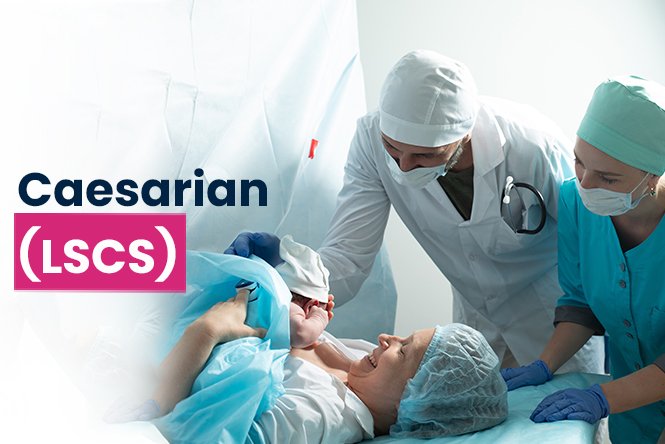
Childbirth is a natural and beautiful process, but sometimes, due to various medical reasons, a vaginal delivery may not be possible or safe for the mother or baby. In such cases, a Caesarean section, also known as C-section or LSCS (Lower Segment Caesarean Section), becomes necessary.
Dr Poonam Goyal stands as a ray of expertise and compassion in the fields of obstetrics, gynaecology, and assisted reproductive technology (ART). One of the cornerstones of Dr Poonam Goyal's practice is her comprehensive Caesarean services, aimed at ensuring the safety and well-being of mothers and babies during childbirth. With a deep understanding of the complexities of pregnancy and childbirth, Dr. Goyal provides personalised care and support to expectant mothers throughout their journey.
With over 36 years of experience in gynaecology and obstetrics and 14+ years of specialization in ART, Dr Goyal has earned a reputation for her exceptional clinical skills, dedication to patient care, and commitment to helping couples achieve their dream of parenthood.
What is a Caesarean Section?
A Caesarean section is a surgical procedure in which a baby is delivered through incisions made in the mother's abdomen and uterus. It is typically performed when a vaginal delivery is not possible or safe for medical reasons.
How is the Caesarean Section conducted?
- Preoperative Preparation: Before the procedure, the mother undergoes preoperative preparation, which includes medical evaluation, blood tests, and obtaining informed consent. An intravenous (IV) line is placed to administer fluids and medications during surgery.
-
Anaesthesia: The mother is given regional anaesthesia, such as epidural or spinal anaesthesia, to numb the lower half of her body while remaining awake during the procedure. In some cases, general anaesthesia may be used if regional anaesthesia is not feasible or safe.
-
Incision: Once the anaesthesia takes effect, the surgeon makes a horizontal incision, known as a Pfannenstiel incision, in the lower abdomen, just above the pubic hairline. This incision is made through the skin and underlying tissues to access the uterus.
-
Uterine Incision: The surgeon then makes an incision in the lower segment of the uterus, usually horizontal (transverse) or vertical (longitudinal), depending on the circumstances. A transverse incision is more common and associated with lower risks of complications.
-
Delivery of the Baby: After the uterine incision, the surgeon gently delivers the baby through the incisions in the abdomen and uterus. The baby is carefully handled and handed over to the pediatric team for assessment and care.
-
Placental Delivery: Following the delivery of the baby, the placenta is removed from the uterus, either manually or with gentle traction. The uterus is then examined for any bleeding or abnormalities and repaired if necessary.
-
Closure: The incisions in the uterus and abdomen are closed with dissolvable sutures or staples. The skin incision may be closed with sutures, staples, or adhesive strips, depending on the surgeon's preference.
-
Postoperative Care: After the procedure, the mother is monitored closely in the recovery room for any signs of complications, such as bleeding, infection, or anaesthesia-related effects. Pain medications and antibiotics may be prescribed as needed.
Why is a Caesarean Section Needed?
Caesarean section may be needed for various medical reasons, including:
- Fetal Distress: When the baby shows signs of distress, such as abnormal heart rate patterns, during labour.
-
Prolonged Labor: When labour fails to progress normally or becomes prolonged, putting the mother or baby at risk.
-
Placenta Previa: When the placenta partially or completely covers the cervix, obstructing vaginal delivery.
-
Breech Presentation: When the baby is positioned feet or buttocks first instead of headfirst, increasing the risk of complications during vaginal delivery.
-
Maternal Health Conditions: When the mother has certain medical conditions, such as preeclampsia, diabetes, or heart disease, that make vaginal delivery unsafe.
-
Previous Cesarean Section: When a woman has had a previous C-section, a repeat C-section may be recommended due to the risk of uterine rupture during vaginal delivery.
-
Why choose Dr Poonam
- Expert Consultation: Dr Goyal begins by offering expert consultation to expectant mothers, discussing their medical history, pregnancy concerns, and birth preferences. She takes the time to address any questions or anxieties, empowering mothers to make informed decisions about their childbirth experience.
-
Individualized Care: Dr Goyal believes in the importance of individualized care, recognizing that each pregnancy is unique and may require specialized attention. She works closely with expectant mothers to develop personalised birth plans tailored to their specific needs and preferences.
-
Advanced Monitoring: Throughout pregnancy, Dr Goyal employs advanced monitoring techniques to ensure the health and well-being of both mother and baby. From regular check-ups and ultrasound scans to fetal heart rate monitoring, she keeps a close eye on the progress of the pregnancy, identifying any potential concerns early on.
-
Skilled Surgical Expertise: In cases where a vaginal delivery is not feasible or safe, Dr. Goyal offers skilled surgical expertise in performing Caesarean sections. With her extensive experience and precision, she ensures a safe and smooth delivery, prioritizing the health and safety of both mother and baby.
-
Postnatal Support: Following the birth, Dr Goyal provides comprehensive postnatal support to mothers, offering guidance on breastfeeding, newborn care, and postpartum recovery. She remains accessible to address any concerns or complications that may arise, ensuring a seamless transition to motherhood.
